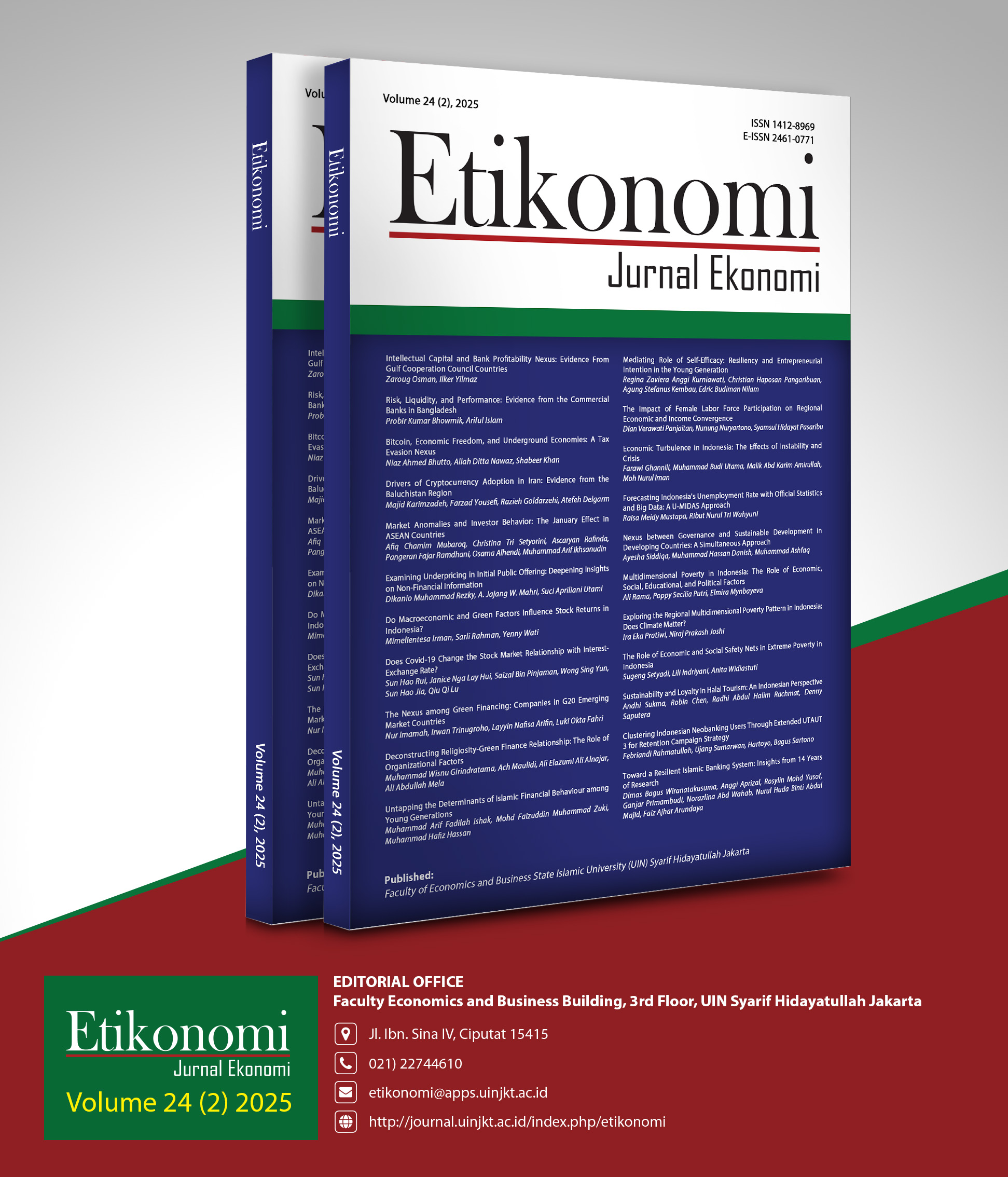Forecasting Indonesia's Unemployment Rate with Macroeconomic & Big Data: A MIDAS Approach
DOI:
https://doi.org/10.15408/etk.v24i2.41760Keywords:
forecasting, midas, unemployment rate, Google Trends IndexAbstract
Research Originality: The current model is unable to forecast the unemployment rate utilizing varying periods of predictor variables. Furthermore, the use of official statistics and big data in previous studies to forecast Indonesia's unemployment rate has been limited.
Research Objectives: This study forecasts Indonesia's biannual unemployment rate (UR) by utilizing monthly Google Trends Index (GTI) data, quarterly Gross Domestic Product (GDP) data, and monthly inflation data.
Research Methods: The unrestricted mixed data sampling (U-MIDAS) model is applied to forecast Indonesia's UR using data from the second semester of 2006 to the first semester of 2024.
Empirical Results: This study finds that the best model for predicting UR is one that utilizes a combination of big data and official statistics. Using 34 GTI keywords relevant to job seekers' cultural and behavioral patterns in Indonesia, Indonesia's UR in February 2024 was 4.7%.
Implications: This study demonstrates that employing GTI and macroeconomic variables for forecasting unemployment enhances predictive accuracy compared to utilizing either variable independently.
JEL Classification: C55, E24, J64
Downloads
References
Adu, W. K., Appiahene, P., & Afrifa, S. (2023). VAR, ARIMAX and ARIMA Models For Nowcasting Unemployment Rate in Ghana Using Google Trends. Journal of Electrical Systems and Information Technology, 10(1), 1–16. https://doi.org/10.1186/s43067-023-00078-1.
Afkham, M., Ghoddusi, H., & Rafizadeh, N. (2021). Google Search Explains Your Gasoline Consumption! Energy Economics, 99, 105305. https://doi.org/10.1016/j.eneco.2021.105305.
Ball, L., Leigh, D., & Loungani, P. (2017). Okun’s Law: Fit at 50? Journal of Money, Credit and Banking, 49(7), 1413–1441. https://doi.org/10.1111/jmcb.12420.
Borup, D., & Schütte, E. C. M. (2022). In Search of a Job: Forecasting Employment Growth Using Google Trends. Journal of Business & Economic Statistics, 40(1), 186-200. https://doi.org/https://doi.org/10.1080/07350015.2020.1791133.
Costa, E. A., Silva, M. E., & Galvão, A. B. (2024). Real-Time Nowcasting the Monthly Unemployment Rates with Daily Google Trends Data. Socio-Economic Planning Sciences, 95, 101963. https://doi.org/10.1016/j.seps.2024.101963.
Crump, R. K., Eusepi, S., Giannoni, M., & Şahin, A. (2024). The Unemployment–Inflation Trade-Off Revisited: The Phillips Curve in COVID Times. Journal of Monetary Economics, 145, 103580. https://doi.org/10.1016/j.jmoneco.2024.103580.
D’Amuri, F., & Marcucci, J. (2017). The Predictive Power of Google Searches in Forecasting US Unemployment. International Journal of Forecasting, 33(4), 801–816. https://doi.org/10.1016/j.ijforecast.2017.03.004.
Davidescu, A. A., Apostu, S. A., & Marin, A. (2021). Forecasting The Romanian Unemployment Rate in Time of Health Crisis—A Univariate Vs. Multivariate Time Series Approach. International Journal of Environmental Research and Public Health, 18(21), 1–31. https://doi.org/10.3390/ijerph182111165.
Dillahunt, T. R., Israni, A., & Lu, A. J. (2021). Examining The Use of Online Platforms for Employment: A Survey of U.S. Job Seekers. Conference on Human Factors in Computing Systems - Proceedings. https://doi.org/10.1145/3411764.3445350.
Dilmaghani, M. (2018). The Racial Digital Divide in The Predictive Power of Google Trends Data for Forecasting the Unemployment Rate. Journal of Economic and Social Measurement, 43(3–4), 119–142. https://doi.org/10.3233/JEM-180458.
Fajar, M., Rizky Prasetyo, O., Fajar, M., Prasetyo, O. R., & Nonalisa, S. (2020). Forecasting Unemployment Rate in the Time of COVID-19 Pandemic Using Google Trends Data (Case of Indonesia). International Journal of Scientific Research in Multidisciplinary Studies, 6(11), 29–33.
Fondeur, Y., & Karamé, F. (2013). Can Google Data Help Predict French Youth Unemployment? Economic Modelling, 30(1), 117–125. https://doi.org/10.1016/j.econmod.2012.07.017.
Gayaker, S., & Türe, H. (2025). National Unemployment Rate Forecast with Google Trends. Mehmet Akif Ersoy Üniversitesi İktisadi ve İdari Bilimler Fakültesi Dergisi, 12(1), 107–123.
Ghasemaghaei, M. (2021). Understanding The Impact of Big Data on Firm Performance: The Necessity of Conceptually Differentiating Among Big Data Characteristics. International Journal of Information Management, 57, 102055. https://doi.org/10.1016/j.ijinfomgt.2019.102055.
Ghysels, E., Kvedaras, V., & Zemlys, V. (2016). Mixed Frequency Data Sampling Regression Models: The R Package midasr. Journal of Statistical Software, 72(4), 1-35.
Haini, H., Musa, S. F., Loon, P., W., & Basir, K. H. (2023). Does Unemployment Affect the Relationship Between Income Inequality and Food Security? International Journal of Sociology and Social Policy, 43(1-2), 48-66. https://doi.org/10.1108/ijssp-12-2021-0303.
Jawadi, F., Mallick, S. K., Idi Cheffou, A., & Augustine, A. (2021). Does Higher Unemployment Lead to Greater Criminality? Revisiting The Debate Over the Business Cycle. Journal of Economic Behavior and Organization, 182, 448–471. https://doi.org/10.1016/j.jebo.2019.03.025.
Johnson, R. A., & Bhattacharyya, G. K. (2019). Statistics: Principles and Methods (8th edition). New Jersey: Wiley.
Kang, W., Ratti, R. A., & Vespignani, J. (2020). Global Commodity Prices and Global Stock Market Volatility Shocks: Effects Across Countries. Journal of Asian Economics, 71, 101249. https://doi.org/10.1016/j.asieco.2020.101249.
Mathai, A., Provost, S., & Haubold, H. (2022). Multivariate Statistical Analysis in the Real and Complex Domains. Berlin: Springer International Publishing.
Mulero, R., & Garcia-Hiernaux, A. (2022). Forecasting Unemployment with Google Trends: Age, Gender and Digital Divide. Empirical Economics, 65(2), 587–605. https://doi.org/10.1007/s00181-022-02347-w.
Naccarato, A., Falorsi, S., Loriga, S., & Pierini, A. (2018). Combining Official and Google Trends Data to Forecast the Italian Youth Unemployment Rate. Technological Forecasting and Social Change, 130, 114–122. https://doi.org/10.1016/j.techfore.2017.11.022.
Ngubane, M. Z., Mndebele, S., & Kaseeram, I. (2023). Economic Growth, Unemployment and Poverty: Linear and Non-Linear Evidence from South Africa. Heliyon, 9(10), e20267. https://doi.org/10.1016/j.heliyon.2023.e20267.
Ormerod, P., Nyman, R., & Bentley, R. A. (2014). Nowcasting Economic and Social Data: When and Why Search Engine Data Fails, An Illustration Using Google Flu Trends. ArXiv Preprint. https://doi.org/https://doi.org/10.48550/arXiv.1408.0699.
Pohlan, L. (2019). Unemployment and Social Exclusion. Journal of Economic Behavior and Organization, 164, 273–299. https://doi.org/10.1016/j.jebo.2019.06.006.
Simionescu, M., & Cifuentes-Faura, J. (2022). Can Unemployment Forecasts Based on Google Trends Help Government Design Better Policies? An Investigation Based on Spain and Portugal. Journal of Policy Modeling, 44(1), 1–21. https://doi.org/10.1016/j.jpolmod.2021.09.011.
Smith, P. (2016). Google’s MIDAS Touch: Predicting UK Unemployment with Internet Search Data. Journal of Forecasting, 35(3), 263–284. https://doi.org/10.1002/for.2391.
Tarsidin, Idham, & Rakhman, R. N. (2018). Nowcasting Household Consumption and Investment in Indonesia. Bulletin of Monetary Economics and Banking, 20(3), 375–404. https://doi.org/https://doi.org/10.21098/bemp.v20i3.858.
Tungtrakul, T., Kingnetr, N., & Sriboonchitta, S. (2016). An Empirical Confirmation of the Superior Performance of MIDAS over ARIMAX. In: Huynh, V. N., Inuiguchi, M., Le, B., Le, B., Denoeux, T. (Eds). Integrated Uncertainty in Knowledge Modelling and Decision Making. IUKM 2016. Lecture Notes in Computer Science, 9978. Cham: Springer.
Vicente, M. R., López-Menéndez, A. J., & Pérez, R. (2015). Forecasting Unemployment with Internet Search Data: Does It Help to Improve Predictions When Job Destruction Is Skyrocketing? Technological Forecasting and Social Change, 92, 132–139. https://doi.org/10.1016/j.techfore.2014.12.005.
Widyarsi, L., & Usman, H. (2021). The Use of Google Trends Data for Forecasting Open Unemployment Rates at National and Regional Levels in West Java Province. Seminar Nasional Official Statistics, 2021(1), 980–990.
Zatzaha, N. M., Suprihatinb, B., & Zunaidahc. (2020). The Influence of Socio Demographic Factors On Job Search Duration For Educated Workers in South Sumatera Province. Jurnal Dialektika, 6, 55–64.
Downloads
Published
Issue
Section
License
Copyright (c) 2025 Raisa Meidy Mustapa, Ribut Nurul Tri Wahyuni

This work is licensed under a Creative Commons Attribution-ShareAlike 4.0 International License.










